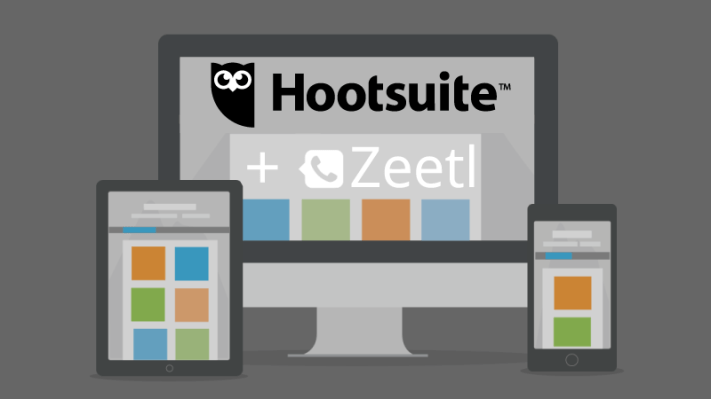Hootsuite, a platform that lets businesses and individuals monitor and manage social media interactions across some 35 different social networks, is stepping up its game with yet more funding and another acquisition. It has raised a further $60 million, and it is acquiring Zeetl, which creates shortlinks to convert text-based interactions between businesses on customers on social media into more direct voice calls.
Zeetl, which had received an undisclosed amount of funding from Vancouver incubator Growlab Ventures, is also based in Vancouver, like HootSuite. The terms of the deal were not disclosed.
Both pieces of news come just weeks after HootSuite bought BrightKit, a social campaign planning tool, with news leaking out on the same day that the company had raised another $35 million.
Ryan Holmes, Hootsuite’s founder and CEO, said in an interview this week that the funds will be used to continue scaling the business — which he says now has “north of” 10 million users, with 1,600 enterprises, including 750 Fortune-1000 companies, among them.
“We are doubling down on our business,” he says. “We’re looking at more international expansion. We’re seeing a lot of growth out of Latin America and so we’re looking at expanding there, as well as continuing product innovation and additional acquisitions.”
The $60 million of new funding was led by a “large Boston-based asset manager,” Hootsuite says. It is not naming Fidelity, but the Wall Street Journal reported a couple of weeks ago that Fidelity had made a $35 million investment in the company. That investment valued Hootsuite at $800 million; it’s not clear if the additional $25 million being disclosed today bumps that number up higher although there are murmurs that it’s now valued at around $1 billion.
Existing investors Accel Partners, Insight Venture Partners and OMERS Ventures, and technology lender Silicon Valley Bank, also participated. The total raised by Hootsuite is now at $250 million.
Although the large majority of Hootsuite’s customers are still at the “free” end of the freemium spectrum, Holmes says that the company has had a strong year since announcing a $165 million round in August 2013.
“We’ve had record-breaking sales and are signing our biggest deals ever,” he says. It’s not disclosing what those revenues are. The company, he adds, is “intentionally cash-flow negative” — in other words, reinvesting what might otherwise be a profit back into its growth.
Hootsuite’s approach has some similarities to route taken by other freemium-based tech companies that target business users (Evernote is one example): it adds new features across the board, and charging for those who want to use them more.
“We’ve been building up functionality for power users to manage content across multiple channels. Much of that functionality is similar for enterprise groups, but for them we also layer in functionality like compliance and workflow and provisioning.”
This is coupled with a strong commitment at Hootsuite to hold on to its consumer-based roots, and not become another enterprise monstrosity. “Servicing both free and paying users keeps us honest,” says Holmes. “The idea is that we stop Hootsuite from becoming ‘over-enterprisey’ and remains something that my grandmother can use.” (That sounds like a pretty hip granny, Ryan.)
The acquisition of Zeetl fits in with that strategy, too. “You’ll be seeing this appearing in products soon,” Holmes says of the shortlinks that can appear in social messages. Once clicked, a customer can link up with the customer service person either through a VoIP call or a call to a regular phone if a number is provided.
Holmes believes that while social media has definitely transformed how businesses communicate with their customers, at some point you will want that conversation to become more involved than you can handle in public messages, or even 140-character DMs on Twitter. This is where direct calling will come in handy.
“Picture someone raising a customer service issue with a brand on Twitter. Trying to respond in 140 characters can be hard to do,” he says. “What this will do is allow a customer service person to send a link, and if you click on it it authenticates the account and once it figures out it is the right person it gives a number to call off desktop, Skype or phone.”
You can see a lot of potential in those mechanics, used not just for customer service inquiries but for sales and other marketing (which could prove onerous for users, but we’ll have to see).
Another area where Hootsuite is likely to look soon, Holmes says, is in advertising, with more functionality to post ads on the platform to complement the marketing activities that Hootsuite already enables.
“Advertising is a huge play for us,” he says. “We expect to see something in Q4 or Q1 of this year. This is part of why our partnerships are so important. We’ve worked with them to get APIs in place to allow our users to post great organic content.” The idea here will be to integrate the data and insights that Hootsuite gets across its existing platform, with making more intelligent ad buys, “which types of content to amplify and at what time of day.”
Right now that would likely mean advertising on Twitter and Facebook, which together account for about 80% of the traffic that goes via Hootsuite (in an equal split). But even as these companies move deeper into analytics, enterprise offerings and advertising themselves, Hootsuite will remain, Holmes says, complementary to, and not competitive with, companies like these.
“We liken ourselves to a social media Switzerland,” he says. “The ability to sit between the social networks is important.”
